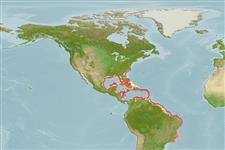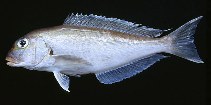Caulolatilus chrysops (Valenciennes, 1833)
Atlantic goldeneye tilefish
Beobachtung melden im Fish Watcher
| Native range | All suitable habitat | Point map | Year 2050 |

|
| This map was computer-generated and has not yet been reviewed. |
| Caulolatilus chrysops AquaMaps Data sources: GBIF OBIS |
Hochladen Photos und videos
Pictures | Google BildCaulolatilus chrysops
Picture by Kolding, J.
Pictures | Google BildCaulolatilus chrysops
Picture by Kolding, J.
Klassifizierung / Names Namen | Synonyme | Catalog of Fishes(Gattung, Arten) | ITIS | CoL | WoRMS | Cloffa
> Eupercaria/misc (Various families in series Eupercaria) > Latilidae (Deepwater tilefishes)
Etymology: Caulolatilus: Greek, kaulos = stem, stalk + Latin, latus = wide (Ref. 45335).
More on author: Valenciennes.
Etymology: Caulolatilus: Greek, kaulos = stem, stalk + Latin, latus = wide (Ref. 45335).
More on author: Valenciennes.
Environment: milieu / climate zone / depth range / distribution range Ökologie
seewasser demersal; tiefenbereich 76 - 244 m (Ref. 5217). Tropical; 35°N - 24°S
Verbreitung Länder | FAO Gebiete | Ecosystems | Vorkommen | Point map | Einführungen | Faunafri
Western Atlantic: North Carolina and Dry Tortugas, Florida (USA), major part of the Antilles to Rio de Janeiro, Paraná (Ref. 47377) and Sao Paulo, Brazil (Ref. 7251). Throughout Caribbean (Dooley, pers. comm., Ref. 26938).
Size / Gewicht / Alter
Maturity: Lm ? range ? - ? cm
Max length : 60.0 cm TL Männchen/unbestimmt; (Ref. 7251); common length : 44.0 cm TL Männchen/unbestimmt; (Ref. 9626)
Max length : 60.0 cm TL Männchen/unbestimmt; (Ref. 7251); common length : 44.0 cm TL Männchen/unbestimmt; (Ref. 9626)
Inhabits rubble bottoms. Feeds mainly on crustaceans and other invertebrates; occasionally on small fishes. Flesh not appreciated (Ref. 5217). Minimum depth from Ref. 47377. Traded as an aquarium fish at Ceará, Brazil (Ref. 49392).
Life cycle and mating behavior Geschlechtsreife | Fortpflanzung | Ablaichen | Eier | Fecundity | Larven
Hauptreferenz
Upload your references | Referenzen | Koordinator | Partner
Dooley, J.K., 1978. Systematics and biology of the tilefishes (Perciformes: Branchiostegidae and Malacanthidae) with descriptions of two new species. NOAA Tech. Rep. NMFS Circ. No. 411:1-78. (Ref. 8991)
IUCN Rote Liste Status (Ref. 130435: Version 2024-2)
nicht bedroht (LC) ; Date assessed: 29 January 2013
CITES
Not Evaluated
Bedrohung für Menschen
Harmless
Nutzung durch Menschen
Fischereien: kommerziell; Sportfisch: ja; Aquarium: Kommerziell
FAO - Fischereien: landings; Publication: search | FishSource | Sea Around Us
Mehr Information
Population dynamics
Growth parameters
Max. ages / sizes
Length-weight rel.
Length-length rel.
Längenhäufigkeiten
Mass conversion
Rekrutierung
Dichte
Growth parameters
Max. ages / sizes
Length-weight rel.
Length-length rel.
Längenhäufigkeiten
Mass conversion
Rekrutierung
Dichte
Life cycle
Fortpflanzung
Geschlechtsreife
Maturity/Gills rel.
Fecundity
Ablaichen
Spawning aggregations
Eier
Eientwicklung
Larven
Larven Pop.Dyn.
Fortpflanzung
Geschlechtsreife
Maturity/Gills rel.
Fecundity
Ablaichen
Spawning aggregations
Eier
Eientwicklung
Larven
Larven Pop.Dyn.
Anatomy
Kiemenoberfläche
Brain
Otolith
Kiemenoberfläche
Brain
Otolith
Physiology
Body composition
Nutrients
Oxygen consumption
Swimming type
Swimming speed
Visual pigments
Fish sound
Diseases & Parasites
Toxicity (LC50s)
Body composition
Nutrients
Oxygen consumption
Swimming type
Swimming speed
Visual pigments
Fish sound
Diseases & Parasites
Toxicity (LC50s)
Genetics
Genetik
Heterozygosity
Vererbbarkeit
Genetik
Heterozygosity
Vererbbarkeit
Human related
Aquaculture systems
Aquakultur Profile
Zuchtlinien
Ciguatera cases
Stamps, coins, misc.
Aquaculture systems
Aquakultur Profile
Zuchtlinien
Ciguatera cases
Stamps, coins, misc.
Tools
E-book | Feldführer | Bestimmungsschlüssel | Längenhäufigkeits Tool | Lebensdaten Tool | Punkt Karte | Classification Tree
| Catch-MSY |
Zusatzinformationen
Download XML
Zusammenfassung | Point data | Namen | Photos
Internet Quellen
AFORO (otoliths) | Aquatic Commons | BHL | Cloffa | BOLDSystems | Websites from users | FishWatcher Einträge suchen | CISTI | Catalog of Fishes: Gattung, Arten | DiscoverLife | ECOTOX | FAO - Fischereien: landings; Publication: search | Faunafri | Fishipedia | Fishtrace | GenBank: Genom, nucleotide | GloBI | GoMexSI (interaction data) | Google Books | Google Scholar | Google | IGFA World Record | MitoFish | Otolith Atlas of Taiwan Fishes | PubMed | Reef Life Survey | Socotra Atlas | Tree of Life | Wikipedia: Gehe zu, Suchen | World Records Freshwater Fishing | Zoological Record
Estimates based on models
Preferred temperature (Ref. 123201): 17.1 - 25.2, mean 21.3 °C (based on 78 cells).
Phylogenetic diversity index (Ref. 82804): PD50 = 0.5005 [Uniqueness, from 0.5 = low to 2.0 = high].
Bayesian length-weight: a=0.00741 (0.00437 - 0.01257), b=3.10 (2.94 - 3.26), in cm total length, based on LWR estimates for this species & (Sub)family-body (Ref. 93245).
Trophic level (Ref. 69278): 3.6 ±0.51 se; based on food items.
Widerstandsfähigkeit (Ref. 120179): mittel, Verdopplung der Population dauert 1,4 - 4,4 Jahre. (Preliminary K or Fecundity.).
Fishing Vulnerability (Ref. 59153): Moderate vulnerability (44 of 100).
Climate Vulnerability (Ref. 125649): High to very high vulnerability (66 of 100).
Nutrients (Ref. 124155): Calcium = 86.4 [58.1, 166.7] mg/100g; Iron = 1.05 [0.67, 1.69] mg/100g; Protein = 16.6 [14.3, 19.6] %; Omega3 = 0.237 [0.153, 0.371] g/100g; Selenium = 73.4 [37.9, 144.5] μg/100g; VitaminA = 28.3 [10.5, 78.0] μg/100g; Zinc = 0.968 [0.698, 1.358] mg/100g (wet weight);




